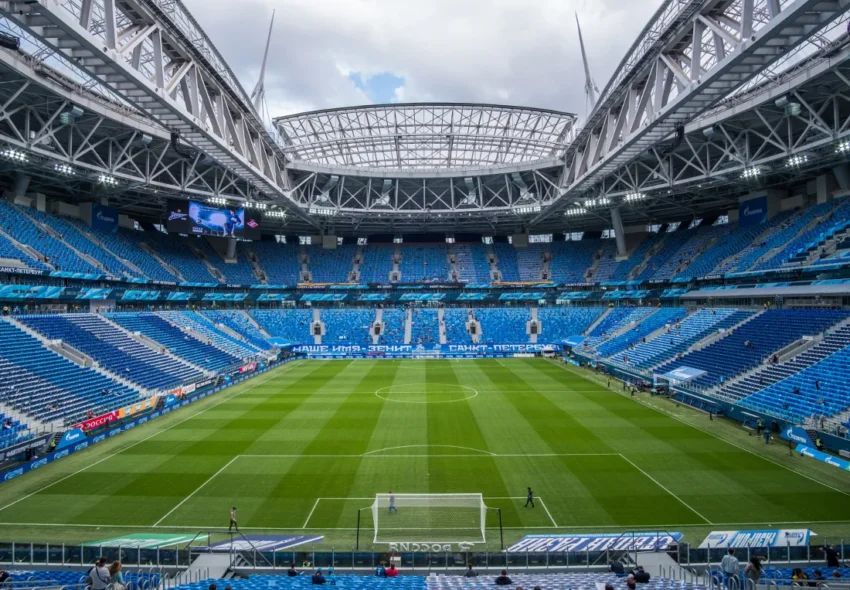The Krestovsky Stadium, also known as Saint Petersburg Stadium, stands as a striking symbol of modern architectural innovation and sporting excellence in Russia. Nestled on Krestovsky Island in Saint Petersburg, this stadium is a testament to Russia’s ambitions to create world-class sporting venues capable of hosting the Olympics, FIFA World Cup matches, and a myriad of other events. Its sleek design, cutting-edge facilities, and cultural significance combine to make it a must-visit landmark for sports enthusiasts and travelers alike. This comprehensive exploration will delve into the stadium’s history, architecture, significance, and impact on the modern sporting landscape in Russia.
The Historical Evolution of Krestovsky Stadium
Understanding the history of the Krestovsky Stadium requires examining its development from conception to today. Originally built for the 2017 FIFA Confederations Cup and 2018 FIFA World Cup, the stadium encapsulates Russia’s vision of showcasing its modernization and commitment to global sports vuabet88.
The journey began in the early 2000s when Saint Petersburg authorities recognized the need for a state-of-the-art arena to replace older, less functional venues. The city aimed to acquire a facility that could host international sports events, cultural festivals, and large-scale concerts, reflecting Russia’s growing influence on the world stage. Development was initially met with mixed receptions, with debates over cost, design, and environmental impact.
Construction officially kicked off in 2007, marked by innovative engineering techniques and international collaborations. The project faced its share of delays, financial challenges, and political scrutiny but ultimately emerged as a symbol of resilience and ambition. The stadium debuted in 2017, featuring extensive upgrades and modern amenities aligned with FIFA standards. Its successful hosting of the FIFA World Cup elevated Saint Petersburg’s global profile, illustrating the strategic importance placed upon such a landmark.
The evolution of Krestovsky Stadium signifies more than just an architectural feat; it embodies Russia’s push toward rebranding its sporting infrastructure and cultural identity. Its history reflects a pattern of persistent ambition, strategic planning, and adaptability, serving not only as a venue but as a symbol of national pride and progress.
Architectural Design and Structural Innovation
The Krestovsky Stadium is renowned for its innovative architectural design that seamlessly blends aesthetics with functionality. Its appearance is characterized by a distinctive, lightweight roof structure that creates an open, airy ambiance while providing protection from weather elements.
Visionary Architectural Concepts
The core idea behind the design was to create a stadium that feels integrated into its surrounding environment, symbolizing transparency and modernity. The roof, constructed with a complex network of steel and glass, resembles an intricate web that crowns the seating bowl, facilitating natural light to penetrate and enhancing visitor experience. This design choice not only reduces energy costs but also provides an eco-friendly footprint, aligning with sustainability goals.
The stadium’s seating capacity exceeds 68,000 spectators, with plans for potential expansion. The seating arrangement emphasizes sightlines and acoustics, ensuring an immersive experience whether attending a football match, concert, or other event. The stadium’s facade features large glass panels and sleek metallic textures, contributing to its futuristic aesthetic.
Structural Engineering and Sustainability Features
High-level engineering innovations underpin the stadium’s structural integrity and environmental sustainability. The roof is supported by a series of cables and trusses, enabling a lightweight yet resilient structure capable of withstanding storm conditions typical of the Baltic region.
Sustainability was a key objective in the design process. The stadium incorporates energy-efficient lighting, water recycling systems, and solar panels integrated into the structure. The glass facade reduces reliance on artificial lighting, which contributes to lower carbon emissions, aligning with global efforts for greener sports venues.
Cultural Symbolism Through Design
The architectural elements also reflect cultural motifs representing Saint Petersburg—its vibrant history, arts, and connection to water. The stadium’s flowing lines and glass facades evoke the city’s serene waterways, bridges, and historic architecture, creating a harmonious blend of tradition and modernity.
The stadium’s design was awarded several international accolades for its ingenuity and eco-friendliness, standing as a testament to Russia’s capacity for creating complex structures that are not only visually stunning but also environmentally conscious. It embodies a forward-thinking approach that many other Krestovsky Stadium worldwide aspire to emulate.
